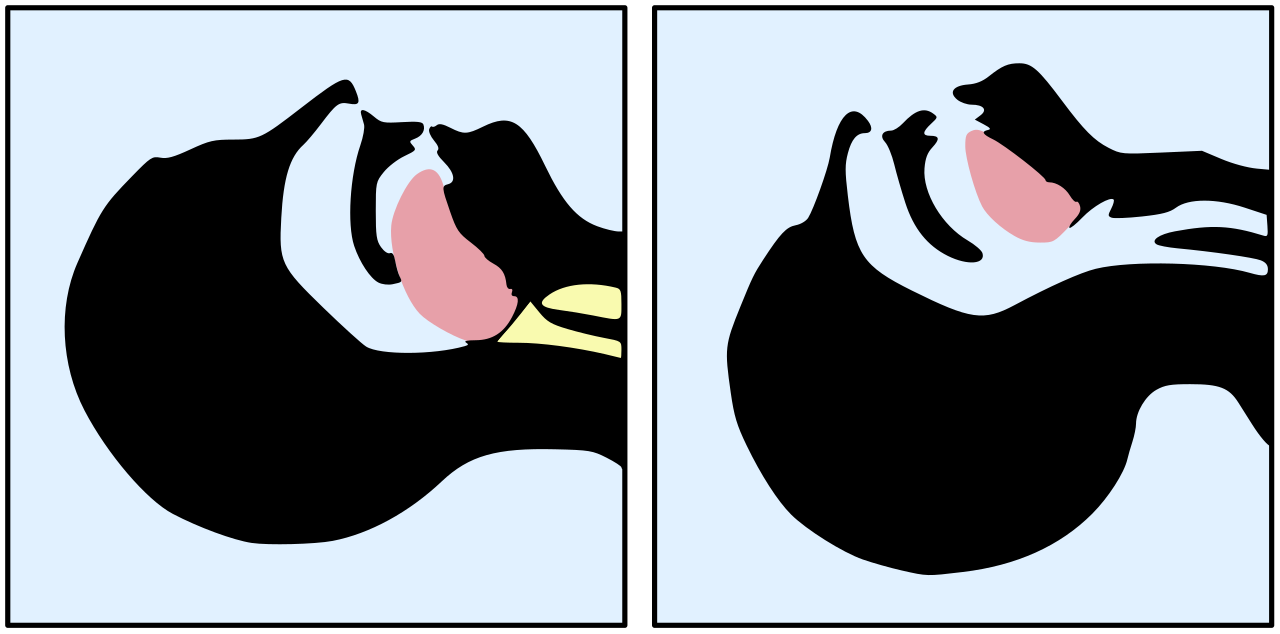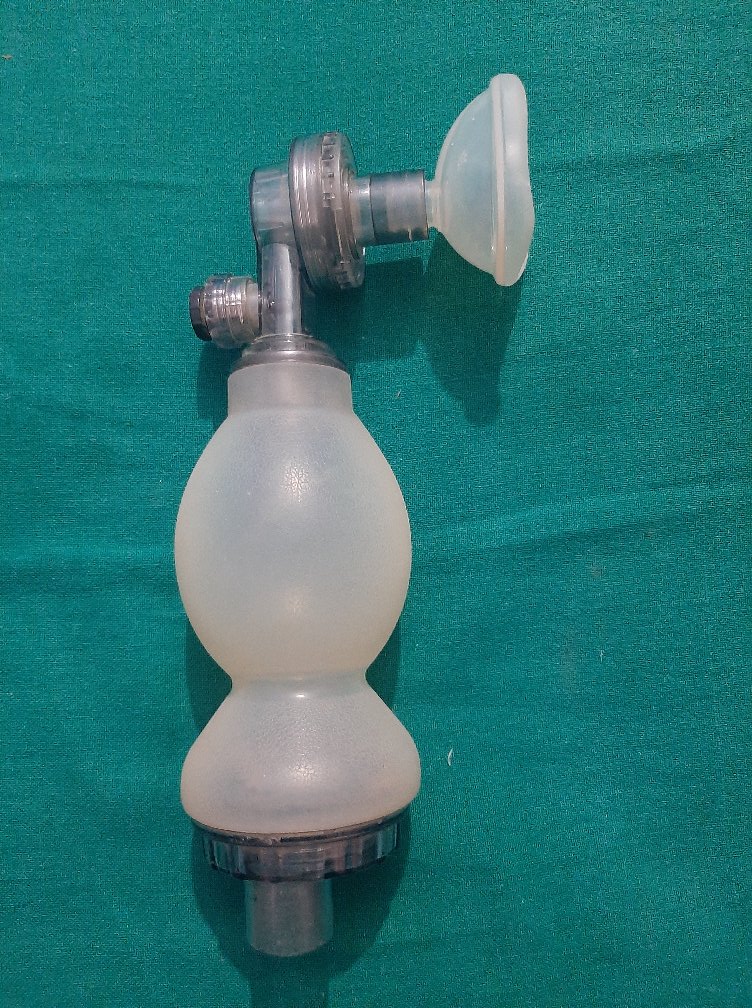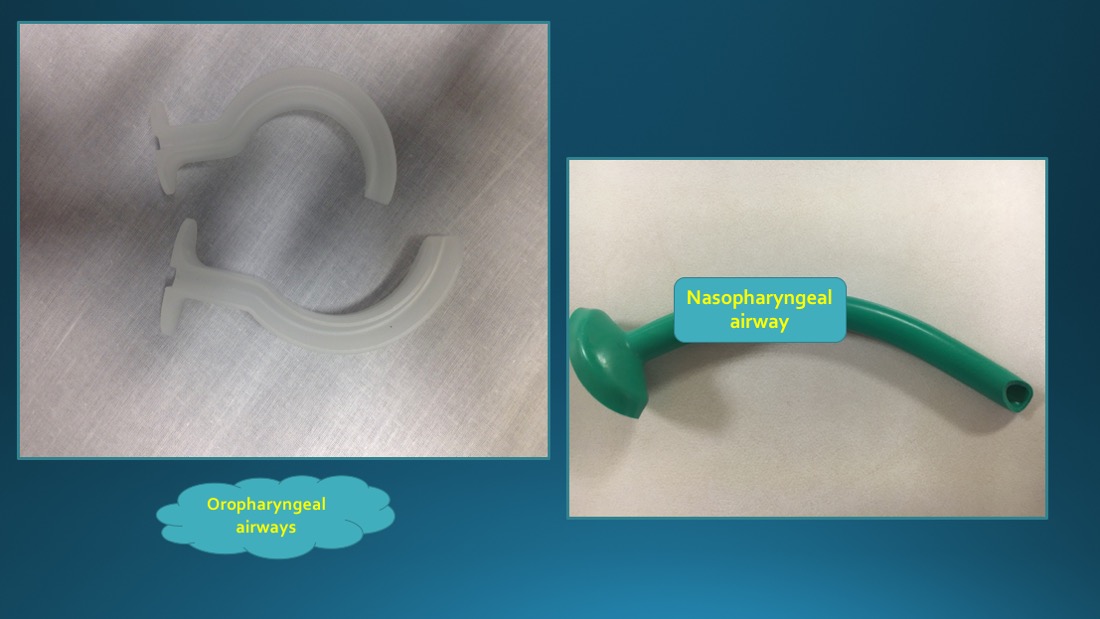Introduction
Bag-valve-mask (BVM) ventilation is a critical skill for emergency care providers. Proficiency requires consistent practice, as this technique is commonly used in urgent and life-threatening situations. Effective ventilation depends on proper patient positioning. Without it, the tongue can fall back against the pharynx, potentially obstructing the airway.
The head tilt–chin lift or jaw thrust maneuver is crucial for maintaining airway patency (see Image. Head Tilt–Chin Lift Maneuver). The "sniffing" position, achieved by flexing the neck forward and aligning the sternal notch with the angle of the mandible, facilitates airway opening. An oropharyngeal (OPA) or nasopharyngeal (NPA) airway may also be used to maintain an open airway. In addition to facilitating airway patency, the sniffing position enhances glottic visualization and increases first-pass success during endotracheal intubation. BVM devices typically include a one-way or pressure-release valve and require a high-flow oxygen source to deliver oxygen effectively to the patient.[1][2][3][4]
Anatomy and Physiology
Register For Free And Read The Full Article
Search engine and full access to all medical articles
10 free questions in your specialty
Free CME/CE Activities
Free daily question in your email
Save favorite articles to your dashboard
Emails offering discounts
Learn more about a Subscription to StatPearls Point-of-Care
Anatomy and Physiology
A comprehensive understanding of oropharyngeal anatomy is essential for effective BVM ventilation. Anatomical variations may present challenges and affect ventilation success. Identifying patients who may be difficult to ventilate is critical. Acronyms such as MOANS (mask seal, obesity, age older than 55, no teeth, stiff lungs) and BONES (beard, obese, no teeth, elderly, snoring or sleep apnea) can help identify these individuals. Patients with these risk factors may benefit from the use of oropharyngeal, nasopharyngeal, or supraglottic airway adjuncts to enhance ventilation success.
Studies have identified several factors that commonly predict difficulty with bag-valve-mask ventilation, including the presence of a beard, obesity, tooth loss, snoring, advanced age, and limited jaw protrusion. When applicable, keeping dentures in place can help improve the mask seal. Facial hair, particularly beards, can hinder ventilation. In such cases, applying a water-soluble lubricant or performing rapid electric shaving may enhance the seal and improve ventilation efficacy.
Indications
Indications for performing BVM ventilation include:
- Hypercapnic respiratory failure
- Hypoxic respiratory failure
- Apnea
- Altered mental status with impaired airway protection
- Anesthesia during elective surgical procedures
- Cardiac arrest
These conditions reflect respiratory insufficiency or compromise, requiring prompt intervention to maintain adequate oxygenation and ventilation. BVM ventilation is a critical life-saving technique that supports effective airway management and oxygen delivery in such critical situations.
Contraindications
Total upper airway obstruction and conditions that increase the risk of aspiration, such as paralysis or induction of anesthesia, are contraindications for BVM ventilation. These factors hinder effective airway access and ventilation. In such situations, alternative airway management strategies, including the use of advanced airway devices, are necessary to ensure adequate oxygenation and minimize the risk of complications such as aspiration.
Equipment
Essential equipment includes a BVM device, an oxygen source, oxygen tubing, a positive end-expiratory pressure (PEEP) valve, and basic airway adjuncts such as oropharyngeal and nasopharyngeal airways (see Images. Bag-Valve-Mask Device and Airway Adjuncts). These items are essential to ensure effective ventilation, maintain airway patency, and provide adequate oxygenation, particularly in patients with compromised respiratory function.
Personnel
BVM ventilation is typically performed by a single provider. However, the involvement of a second provider—who can squeeze the bag while the primary provider maintains the mask seal—is often beneficial. This 2-person approach is generally preferred, as it improves the mask seal, reduces air leaks, and minimizes provider fatigue resulting from the prolonged effort of holding the mask in position, which can be cumbersome and lead to rapid hand fatigue.
Preparation
An oropharyngeal airway may be inserted to displace the tongue forward, preventing airway occlusion when the patient is lying in a supine position. The only true contraindication is the presence of a gag reflex. The airway can be inserted either directly or rotated 90° or 180° to facilitate placement behind the tongue. Care must be taken while rotating the device to prevent injury to the palate.
A nasopharyngeal airway is useful when BVM ventilation is hindered by a large tongue or other obstructions, allowing air to reach the posterior pharynx. This device is contraindicated in cases of facial trauma with suspected fractures, as insertion may risk intracranial penetration. The airway should be lubricated appropriately, inserted with the bevel facing the nasal septum, and gently rotated as needed to extend into the posterior pharynx. These basic airway adjuncts help maintain airway patency and enable effective ventilation.
The rescuer should position themselves at the patient’s head and ensure a tight mask seal, with the pointed end over the nose and the curved end below the lower lip. In the one-person technique, the “E-C seal” is used: the first and second digits (fingers) form a “C” around the mask, the thumb presses the nasal bridge, the second digit applies pressure to the mask’s bottom, and the third through fifth digits form an “E” to apply pressure to the mandible. The mask must fit snugly against the skin with no gaps. The head may be tilted backward using the "head tilt–chin lift" maneuver or the jaw displaced forward using the "jaw-thrust" maneuver, if necessary, to open the airway and facilitate ventilation.
In the 2-person technique, one provider squeezes the bag while the other (rescuer) applies the E-C seal technique using both hands. This method has been demonstrated in simulations to deliver higher tidal volumes and provide a more effective mask seal. Care should be taken to avoid compressing the soft tissues of the neck with the rescuer's fingers, ensuring that sufficient force is applied to maintain an adequate seal.[5]
Proper patient positioning can significantly enhance the effectiveness of ventilation. The sniffing position, where the ear is aligned to the sternal notch in the same plane, optimizes airflow. Using a slightly larger mask than expected may improve the seal, whereas a smaller mask may increase the risk of leaks. Mastering BVM ventilation is challenging. A retrospective review of the Resuscitation Outcomes Consortium found that fewer than half of cardiac arrest patients ventilated during cardiopulmonary resuscitation (CPR) pauses had detectable waveforms, indicating inadequate ventilation. Thorough preparation is essential to ensure sufficient ventilation.[6][7][8][9]
Apneic oxygenation, involving the use of a nasal cannula placed under the BVM at a flow rate of at least 15 L/min, can improve preoxygenation before intubation and reduce the risk of hypoxia.[10][11]
Technique or Treatment
An adult BVM with oxygen supplied at a minimum of 15 L/min and a full reservoir can deliver up to 1.5 liters of oxygen per breath. Ventilation should be provided with caution and only until visible chest rise is observed to minimize the risk of gastric insufflation, which can lead to vomiting and barotrauma from overdistention.
The appropriate ventilation rate for an adult is 10 to 12 breaths per minute, or one breath every 5 to 6 seconds. In emergencies such as respiratory distress or cardiac arrest, deliberate focus is essential to maintain this rate and avoid hyperventilation. The tidal volume needed for an adult is typically 500 to 600 mL, although the bag can deliver up to 1600 mL if fully compressed. The bag should be squeezed only until a visible chest rise occurs, typically about one-third full. The bag should be squeezed slowly, as rapid squeezing increases peak inspiratory pressure, which can contribute to pulmonary barotrauma.
Adequate ventilation is confirmed by observing visible chest rise and fall, auscultating for bilateral breath sounds, and monitoring oxygen saturation. When available, capnography offers real-time feedback on ventilation effectiveness. Poor compliance, absent breath sounds, or a lack of capnographic waveform may indicate ineffective ventilation and the need for immediate reassessment.
Complications
Complications of BVM ventilation include barotrauma from excessive lung inflation and gastric insufflation, which can lead to vomiting and aspiration. Hyperventilation reduces exhalation time and may cause pulmonary barotrauma, such as pneumothorax and arterial gas embolism. Because BVM ventilation delivers positive pressure ventilation, hyperventilation also raises intrathoracic pressure, decreasing central venous return to the heart, reducing right ventricular preload, and impairing effective cardiac resuscitation.
Clinical Significance
The routine use of cricoid pressure during BVM ventilation and endotracheal intubation was once standard practice but has not consistently demonstrated improvements in patient outcomes. Originally, cricoid pressure aimed to occlude the esophagus to prevent gastric regurgitation and reduce aspiration risk. However, some studies suggest that cricoid pressure may displace the esophagus rather than occlude it. Additionally, research has shown that esophageal occlusion may be incomplete depending on the force applied. Further studies indicate that cricoid pressure can obstruct the laryngeal view during intubation, potentially complicating the procedure.[12][13][14]
BVM ventilation may be enhanced with the use of a PEEP valve, which can be adjusted between 5 and 15 cm H2O to improve oxygenation in patients who cannot be adequately preoxygenated by standard methods. However, PEEP should not exceed 20 cm H2O, as higher pressures may open the lower esophageal sphincter, causing gastric insufflation and vomiting. Clinical trials have shown that this approach reduces the incidence of preintubation hypoxia.[15] Additionally, using low-pressure, low-volume insufflation techniques helps prevent gastric distention during ventilation, further minimizing the risk of complications.
Some BVMs are equipped with an attachment site for a pathogen filter, although these filters are not completely foolproof. Personal protective equipment remains essential for all patient interactions, even when using these filters.
The BVM adapter can also accommodate an end-tidal monitor or nebulizer reservoir, enhancing the device’s functionality. However, if the mask seal is inadequate, end-tidal readings may be inaccurate, and nebulized medications can leak, compromising their effectiveness.
Outcomes for patients in cardiac arrest have shown mixed results across different studies, with some showing comparable results between BVM ventilation and endotracheal intubation, whereas others emphasize the critical importance of mastering BVM alone. These findings underscore the importance of proficiency in the BVM technique.[16]
Enhancing Healthcare Team Outcomes
BVM ventilation is a vital technique for managing respiratory distress and is commonly used by emergency medical services personnel, anesthesiologists, intensive care nurses, respiratory therapists, and intensivists. This lifesaving procedure is often easier than intubation and, when performed correctly, provides effective oxygenation until an anesthesiologist can secure the airway. An interprofessional approach is essential to ensure optimal patient care.
Nursing, Allied Health, and Interprofessional Team Interventions
A team approach facilitates the two-person application of BVM ventilation, while other team members prepare for definitive airway management, such as rapid sequence intubation. Additional nursing responsibilities include monitoring pulse oximetry and electrocardiogram (ECG) telemetry, establishing intravenous access, obtaining blood samples for gas analysis, administering medications, setting up and operating suction, maintaining accurate records, and coordinating necessary resources.
Media
(Click Image to Enlarge)

Head Tilt-Chin Lift Maneuver. This technique is the most reliable method for opening the airway. The images demonstrate improved airway patency, with the left image showing the airway before the maneuver and the right showing it after.
Offnfopt, Public Domain, via Wikimedia Commons
(Click Image to Enlarge)
(Click Image to Enlarge)
References
Strzelecki C, Shelton CL, Cunningham J, Dean C, Naz-Thomas S, Stocking K, Dobson A. A randomised controlled trial of bag-valve-mask teaching techniques. The clinical teacher. 2020 Feb:17(1):41-46. doi: 10.1111/tct.13008. Epub 2019 Feb 27 [PubMed PMID: 30811881]
Level 1 (high-level) evidenceCarlson JN, Wang HE. Updates in emergency airway management. Current opinion in critical care. 2018 Dec:24(6):525-530. doi: 10.1097/MCC.0000000000000552. Epub [PubMed PMID: 30239412]
Level 3 (low-level) evidenceKroll M, Das J, Siegler J. Can Altering Grip Technique and Bag Size Optimize Volume Delivered with Bag-Valve-Mask by Emergency Medical Service Providers? Prehospital emergency care. 2019 Mar-Apr:23(2):210-214. doi: 10.1080/10903127.2018.1489020. Epub 2018 Aug 29 [PubMed PMID: 30130437]
Sall FS, De Luca A, Pazart L, Pugin A, Capellier G, Khoury A. To intubate or not: ventilation is the question. A manikin-based observational study. BMJ open respiratory research. 2018:5(1):e000261. doi: 10.1136/bmjresp-2017-000261. Epub 2018 Jul 17 [PubMed PMID: 30116535]
Level 2 (mid-level) evidenceUhm D, Kim A. Tidal volume according to the 4-point sealing forces of a bag-valve-mask: an adult respiratory arrest simulator-based prospective, descriptive study. BMC emergency medicine. 2021 May 1:21(1):57. doi: 10.1186/s12873-021-00451-1. Epub 2021 May 1 [PubMed PMID: 33932998]
Idris AH, Aramendi Ecenarro E, Leroux B, Jaureguibeitia X, Yang BY, Shaver S, Chang MP, Rea T, Kudenchuk P, Christenson J, Vaillancourt C, Callaway C, Salcido D, Carson J, Blackwood J, Wang HE. Bag-Valve-Mask Ventilation and Survival From Out-of-Hospital Cardiac Arrest: A Multicenter Study. Circulation. 2023 Dec 5:148(23):1847-1856. doi: 10.1161/CIRCULATIONAHA.123.065561. Epub 2023 Nov 12 [PubMed PMID: 37952192]
Level 2 (mid-level) evidenceCierniak M, Maksymowicz M, Borkowska N, Gaszyński T. Comparison of ventilation effectiveness of the bag valve mask and the LMA Air-Q SP in nurses during simulated CPR. Polski merkuriusz lekarski : organ Polskiego Towarzystwa Lekarskiego. 2018 May 25:44(263):223-226 [PubMed PMID: 29813039]
Delorenzo A, St Clair T, Andrew E, Bernard S, Smith K. Prehospital Rapid Sequence Intubation by Intensive Care Flight Paramedics. Prehospital emergency care. 2018 Sep-Oct:22(5):595-601. doi: 10.1080/10903127.2018.1426666. Epub 2018 Feb 6 [PubMed PMID: 29405803]
Becker HJ, Langhan ML. Can Providers Use Clinical Skills to Assess the Adequacy of Ventilation in Children During Bag-Valve Mask Ventilation? Pediatric emergency care. 2020 Dec:36(12):e695-e699. doi: 10.1097/PEC.0000000000001314. Epub [PubMed PMID: 29084068]
Uzun DD, Hezel F, Mohr S, Weigand MA, Schmitt FCF. Apnoeic oxygenation in pediatric anesthesia: better safe than sorry! BMC anesthesiology. 2025 Mar 8:25(1):116. doi: 10.1186/s12871-025-02995-2. Epub 2025 Mar 8 [PubMed PMID: 40055595]
Tang H, Yang Y, Li H. High-flow nasal cannula for pre- and apneic oxygenation during rapid sequence induction intubation in emergency surgery: A systematic review and meta-analysis. PloS one. 2025:20(1):e0316918. doi: 10.1371/journal.pone.0316918. Epub 2025 Jan 24 [PubMed PMID: 39854507]
Level 1 (high-level) evidenceCostello JT, Allen PB, Levesque R. A Comparison of Ventilation Rates Between a Standard Bag-Valve-Mask and a New Design in a Prehospital Setting During Training Simulations. Journal of special operations medicine : a peer reviewed journal for SOF medical professionals. 2017 Fall:17(3):59-63. doi: 10.55460/6Q5D-6CL6. Epub [PubMed PMID: 28910470]
Lacerda RS, de Lima FCA, Bastos LP, Fardin Vinco A, Schneider FBA, Luduvico Coelho Y, Fernandes HGC, Bacalhau JMR, Bermudes IMS, da Silva CF, da Silva LP, Pezato R. Benefits of Manometer in Non-Invasive Ventilatory Support. Prehospital and disaster medicine. 2017 Dec:32(6):615-620. doi: 10.1017/S1049023X17006719. Epub 2017 Jul 26 [PubMed PMID: 28743318]
Pearson DA, Darrell Nelson R, Monk L, Tyson C, Jollis JG, Granger CB, Corbett C, Garvey L, Runyon MS. Comparison of team-focused CPR vs standard CPR in resuscitation from out-of-hospital cardiac arrest: Results from a statewide quality improvement initiative. Resuscitation. 2016 Aug:105():165-72. doi: 10.1016/j.resuscitation.2016.04.008. Epub 2016 Apr 27 [PubMed PMID: 27131844]
Level 2 (mid-level) evidenceDai Y, Dai J, Walline JH, Fu Y, Zhu H, Xu J, Yu X. Can bag-valve mask ventilation with positive end-expiratory pressure reduce hypoxia during intubation? A prospective, randomized, double-blind trial. Trials. 2021 Jul 17:22(1):460. doi: 10.1186/s13063-021-05413-3. Epub 2021 Jul 17 [PubMed PMID: 34274023]
Level 1 (high-level) evidenceYuksen C, Phattharapornjaroen P, Kreethep W, Suwanmano C, Jenpanitpong C, Nonnongku R, Sittichanbuncha Y, Sawanyawisuth K. Bag-Valve Mask versus Endotracheal Intubation in Out-of-Hospital Cardiac Arrest on Return of Spontaneous Circulation: A National Database Study. Open access emergency medicine : OAEM. 2020:12():43-46. doi: 10.2147/OAEM.S229356. Epub 2020 Mar 12 [PubMed PMID: 32210644]

